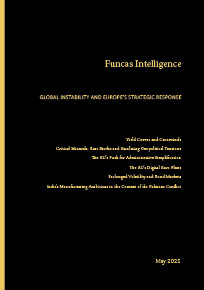Global Instability and Europe's Strategic Response
Fecha: May 2025
Funcas Intelligence, May 2025
Sumario
The divergence between the Federal Reserve’s cautious stance and the ECB’s ongoing rate cuts is reshaping yield curves and driving volatility across global bond markets. Investors face a complex environment shaped by persistent inflation, trade tensions, and uncertain tariff outcomes, requiring active management and geographic diversification in fixed-income strategies.
The global race for rare earths and critical minerals is intensifying as China maintains dominance and uses its leverage to exert influence, and the United States pursues an aggressive approach to increase access to resources overseas. The EU has developed a strategy, but this is not a top priority for Europe for now, making the bloc more vulnerable to supply chain disruptions.
The EU has launched a "simplification revolution" to cut red tape and ease regulatory burdens on businesses, especially SMEs, in the face of mounting pressure. These efforts may not ultimately yield the changes needed to boost European competitiveness and growth, but they represent an admission by EU policymakers that they must begin the process of simplifying regulations and deregulating.
The digital euro is a strategic initiative by the European Central Bank (ECB) to strengthen the EU’s monetary sovereignty in response to EU vulnerabilities and concerns about U.S. policy unpredictability. The initiative is still in its early stages and is being designed as a cautious, small-scale experiment with potential for future expansion.
Dramatic shifts in U.S. economic policy and the announcement that Germany will ramp up investment through the issuance of new debt have caused significant swings in bond yields this spring. Different growth prospects, debt sustainability concerns, political dynamics, and anticipated shifts in monetary policy could all influence how markets respond to changes, creating a more uncertain bond market environment in the months ahead.
India is rapidly growing economically and is increasingly seen as a viable manufacturing alternative to China, though it will not soon replace China as the global manufacturing hub. Despite the current ceasefire, the nature of the recent India-Pakistan conflict erodes investor confidence and potentially undermines India’s broader economic ambitions.

